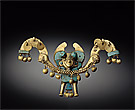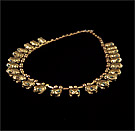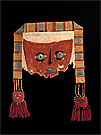Curriculum links English
As visitors enter the Gold and the Incas: Lost worlds of Peru exhibition the following text is prominently displayed:
"Encounter the drama and beauty of the famous Inca Empire and its marvellous predecessors.
See the breathtaking ceramic sculptures, intricate jewellery, elaborate embroidered cloths, dazzling silver and gold treasures of ancient Peru".
As you read more about this exhibition, keep in mind that it celebrates the 50th anniversary of the establishment of diplomatic relations between Peru and Australia as well as being a highlight in the program of events for the Centenary of Canberra celebrations.
An integral component of the visitor experience for the Gold and the Incas: Lost worlds of Peru exhibition is the variety of interpretive information made available to the visitor. These include:
- Standard labels for every work of art in the exhibition. This label has a short amount of text including the culture associated with the work of art, title, the approximate date of making, material and loan institution.
- Extended labels that provide background information on thirty three works of art in the exhibition.
- Wall texts focusing on each culture represented in the exhibition.
- An exhibition brochure that includes the wall texts and further information about the exhibition. This is given to the visitors as they enter the exhibition.
- An adult audio tour which includes entries on thirty works of art in the exhibition.
- A children's audio tour which includes entries on twelve works of art in the exhibition.
- The Gold and the Incas: Lost worlds of Peru exhibition catalogue.
- Gold and the Incas: Lost worlds of Peru website which includes short label, extended label, wall text information and catalogue entries.
- A promotional film in the temporary exhibition foyer (duration 2 minutes, 33 seconds)
- An introductory film at the entrance to the exhibition (duration 10 minutes).
- Associated public programs including introductory sessions, curator's perspectives, films, a masterclass series and a community Fiesta in the NGA precinct.
- December 2013 media release under the heading National Gallery opens major summer exhibition from the NGA's marketing department.
- Family activity room that includes interpretive and hands-on activities for children and families.
- Printed children's trail.
- Exhibition reviews from newspapers, online forums and focus articles.
The Gold and the Incas: Lost worlds of Peru exhibition has strong links with a number of content descriptions across all Secondary School year bands of Australian Curriculum: English. The exhibition can be considered a text or series of texts that can be utilised to assist students develop a range of skills in the English curriculum.
In the Year 7 band of the English curriculum relevant content descriptions from the Literacy strand are:
- Analyse and explain the ways text structures and language features shape meaning and vary according to audience and purpose (ACELY1721)
- Compare the text structures and language features of multimodal texts, explaining how they combine to influence audiences (ACELY1724)
- Plan, draft and publish imaginative, informative and persuasive texts, selecting aspects of subject matter and particular language, visual, and audio features to convey information and ideas (ACELY1725)
In the Year 8 band of the English curriculum relevant content descriptions from the Literacy strand are:
- Analyse and evaluate the ways that text structures and language features vary according to the purpose of the text and the ways that referenced sources add authority to a text (ACELY1732)
- Explore and explain the ways authors combine different modes and media in creating texts, and the impact of these choices on the viewer/listener (ACELY1735)
- Create imaginative, informative and persuasive texts that raise issues, report events and advance opinions, using deliberate language and textual choices, and including digital elements as appropriate (ACELY1736)
In the Year 9 band relevant content descriptions from the Literacy strand are:
- Explore and explain the combinations of language and visual choices that authors make to present information, opinions and perspectives in different texts (ACELY1745)
- Interpret, analyse and evaluate how different perspectives of issue, event, situation, individuals or groups are constructed to serve purposes in texts (ACELY1742)
- Create imaginative, informative and persuasive texts that present a point of view and advance or illustrate arguments, including texts that integrate visual, print and/or audio features (ACELY1746)
In the Year 10 band relevant content descriptions from the Literacy strand include:
- Identify and analyse implicit or explicit values, beliefs and assumptions in texts and how these are influenced by purposes and likely audiences (ACELY1752)
- Create sustained texts, including texts that combine specific digital or media content, for imaginative, informative, or persuasive purposes that reflect upon challenging and complex issues (ACELY1756)
In the Year 11-12 band there are explicit links between the Gold and the Incas: Lost worlds of Peru exhibition and Unit 1 of the Australian Curriculum: English where students explore, by responding and creating, to how meaning is communicated through the relationships between language, text, purpose, context and audience. For the full description of the unit and related content descriptions visit the ACARA site/English.
Receptive modes
- Do you think that the National Gallery of Australia has targeted any particular audience in its marketing of the Gold and the Incas: Lost worlds of Peru exhibition? If so, why do you think this is so?
- How could the addition of the Family activity room in the middle of the exhibition layout affect the audience demographic?
- What effect does the text at the entrance to the exhibition have in setting the scene for visitors as they enter the exhibition?
Productive modes
- Following your visit to the exhibition choose a work of art that inspires you and write a poetic response to your viewing experience. Consider the location of the work of art, the other objects in the vicinity and how it adds to the exhibition display.
- Research a work of art in the exhibition and write an extended label for it. Think about the most important points to include on your label and the style of writing you are going to use. Divide into pairs and edit your partner's work discussing your reasons for any changes you suggest.
- Listen to the children's audio tour to prepare for writing your own version for a year 3-4 audience that incorporates sound and musical elements. Choose 10 works of art that are not included on the Gallery's children's audio tour. Consider who you would choose as narrator and if you would prefer to have one narrator or a dialogue between two. Take into consideration the attention span of your audience in limiting the duration of the tour.
- Evaluate texts in the Gold and the Incas: Lost worlds of Peru exhibition to understand how combinations can enrich the audience's response to the exhibition. Choose from the following list of combinations, identifying the features of each:
- Adult audio tour and promotional film shown in the exhibition foyer
- Children's audio tour and extended labels for 10 works of art
- Room brochure and tour of the exhibition with a Voluntary Guide
- Wall texts, room brochure and promotional film
- Visit to the Family activity room, children's audio tour and 10 minute introductory film adjacent to exhibition entrance
Receptive modes
- Discuss the choice of Phillip Adams as narrator for the Gold and the Incas: Lost worlds of Peru adult audio tour. Research his professional background and determine how dramatically the narration can affect the listener's response to the exhibition. Take into account the audience's familiarity with particular media personalities rather than an unknown voice. Also consider the difference between the written and spoken word and the audience demographic.
- After your visit to the Gold and the Incas: Lost worlds of Peru exhibition your teacher could facilitate a class discussion on the interpretive method that each student found most valuable when viewing the exhibition and why this was so. It would be interesting to survey your classmates to discover one another's learning style preferences: visual learners look and read while aural learners might prefer the audio tour, and kinaesthetic learners, the family activity room.
Productive modes
- After viewing the Gold and the Incas: Lost worlds of Peru exhibition work in groups to develop a storyboard and script for an introductory video to the exhibition. Ask your classmates to consider the intention of the film, the expected audience, major themes of the exhibition and the most important works of art to reference in your script. Each group should present their ideas to the class.
- Create your own children's audio tour with six stops for an upper primary school target audience. Choose a theme from the list below to develop the script focussing on content, language and the duration appropriate to your audience.
- Status and burial
- Empire and the rise and fall of cultures
- Gold and silver
- Landscape and environment
- Materials
- Society – including the role of artists
- Beliefs – including duality and the Andean worldview
Collaborative class exercises:
- Divide into groups, choose a theme from the list above and write short texts about six works of art that address your theme. Each group will therefore develop a specialty area within the exhibition. Present your theme and group of works to the class using the Gallery's website to source the images for your group presentation.
- Once each group has presented to the class, work collaboratively to choose one work of art from each thematic area that most clearly highlights each theme. With your shortlist chosen you should now have a group of objects that presents an overview of the Gold and the Incas: Lost worlds of Peru exhibition.
Receptive modes
- View the promotional film on the Gallery website or in the temporary exhibition foyer en route to the exhibition. Once you have researched the objects in the exhibition discuss the value of this film as a contextual tool in both locations.
- Explore the Gold and the Incas: Lost worlds of Peru website and view the rotating images on the home page. Why do you think the four images were chosen to introduce visitors to the exhibition?
- Read the December 2013 media release under the heading National Gallery opens major summer exhibition. Explore some of the language features of this document and discuss the function of a media release and media preview in promoting the exhibition.
Productive modes
- Develop a written exhibition resource for 10-12 year old visitors to the exhibition which includes ten works of art. Consider the overall design of your resource including how you can incorporate motifs inspired by the exhibition to attract a younger audience. Once each group has completed their resource consider how you could share your work to make a number of different resources that cover all aspects of the exhibition. Each group could choose 2 works of art from their resource to include in a more comprehensive class resource based on the Gold and the Incas: Lost worlds of Peru exhibition.
- As a collaborative class exercise one group could write a ten stop children's audio tour; another could write extended labels for ten works of art, and another group could write an introduction to the exhibition for the media preview etc. There may be enough students in your class to enable a number of collaborative exhibition resources to be developed.
- Develop a promotional video for the Gold and the Incas: Lost worlds of Peru using ipads where members of your class are interviewed to reveal their impression of the exhibition and favourite work of art. Develop your introduction to the video as a summary of the show before crossing to your classmates for their personal insights. Consider what important information to include in the introduction and how varied your classmate's choices may be. Edit the video down to a three minute version for viewing by the whole class.
Receptive modes
Read reviews for the Gold and the Incas exhibition from a number of sources
Evaluate the tone of each review and highlight the language modes used in each. Which do you think was the most persuasive and why?
- If you have access to the exhibition catalogue discuss as a class the layout of the catalogue including the order of the entries and rationale for this order. Consider the content of the texts especially those written by the Minister of Culture of Peru, Minister of the Arts, ACT Minister for Tourism and Events, and Director of the National Gallery of Australia.
- Why is the Gold and the Incas: Lost worlds of Peru exhibition scheduled at this time on the Gallery's exhibition calendar?
- Discuss the signage for the exhibition as you approach the Gallery and enter the building and how signage develops as you make your way to the exhibition entry. How effective is this signage in developing anticipation and excitement as visitors move towards the exhibition?
Productive modes
- Write a review of the Gold and the Incas: Lost worlds of Peru exhibition to be included in your local newspaper. This review should entice readers to visit the show and provide the context of the display by highlighting a number of key objects as well as providing a critique of the strengths and weaknesses of the exhibition.
- Choose two types of texts from the exhibition and compare and contrast the use of language taking into consideration the target audience. Use either the Gold and the Incas: Lost worlds of Peru website, catalogue, exhibition brochures, and/or exhibition texts, adult audio tour, children's audio tour or December 2013 media release under the heading National Gallery opens major summer exhibition.
- Research the departmental structure of the National Gallery of Australia and consider the subtle differences between the writing styles used by the curatorial, learning and access, and marketing and commercial operations teams.
- Compare and contrast the voices and language used in the adult audio tour and children's audio tour and comment on how these features affect audience engagement.
An in-depth study of the variety of texts associated with the Gold and the Incas: lost worlds of Peruexhibition.
Receptive modes
- Discuss how the Gold and the Incas: Lost worlds of Peru catalogue includes information to confirm the close diplomatic relationship between Australia and Peru. Give examples of how and where this is articulated directly and indirectly through the catalogue.
- The adult audio tour, narrated by ABC radio presenter, Phillip Adams, compromises thirty stops where information about the works of art has been embellished with other background information to assist the visitor to gain a greater appreciation of the exhibition. How does the aural mode of communication affect the way information is delivered in the adult audio tour? Discuss the language features you have noticed when listening to the entries.
- Discuss the hierarchy of sponsors who are supporting the Gold and the Incas: Lost worlds of Peru exhibition as displayed in the catalogue or on the exhibition website. Why do you think these organisations are involved? Discuss how these relationships develop and consider their relevance to the cultural sector in Australia.
- Explore how art exhibitions are conceived and developed and discuss the factors that may be considered in approving exhibition proposals.
Productive modes
- Following the Gold and the Incas: Lost worlds of Peru exhibition media launch the exhibition curator, Christine Dixon conducted a number of interviews in the exhibition with local and interstate journalists. Imagine you are the arts writer for your local newspaper. After researching the exhibition prior to the launch, develop questions you would ask Christine that would allow you to write an informed and enticing piece.
- Develop a folder of information for the medial launch of the Gold and the Incas: Lost worlds of Peru exhibition. A folder will be given to each media representative as well as sponsors and foreign dignitaries. Each folder should include a media release, key images from the exhibition, curatorial overview and other related material.
- After visiting the Gold and the Incas: Lost worlds of Peru exhibition and learning about the burial practises of the ancient Andean peoples read the Guardian article by Kim MacQuarrie about a mummy on display in a museum in Argentina. In response, write an editorial piece about this display using a subjective tone.









![| Unku [Tunic] | 1400-1533 AD](images/sml/236005.jpg)

![| Tumi [Sacrificial knife] | 750-1375 AD](images/sml/227551.jpg)